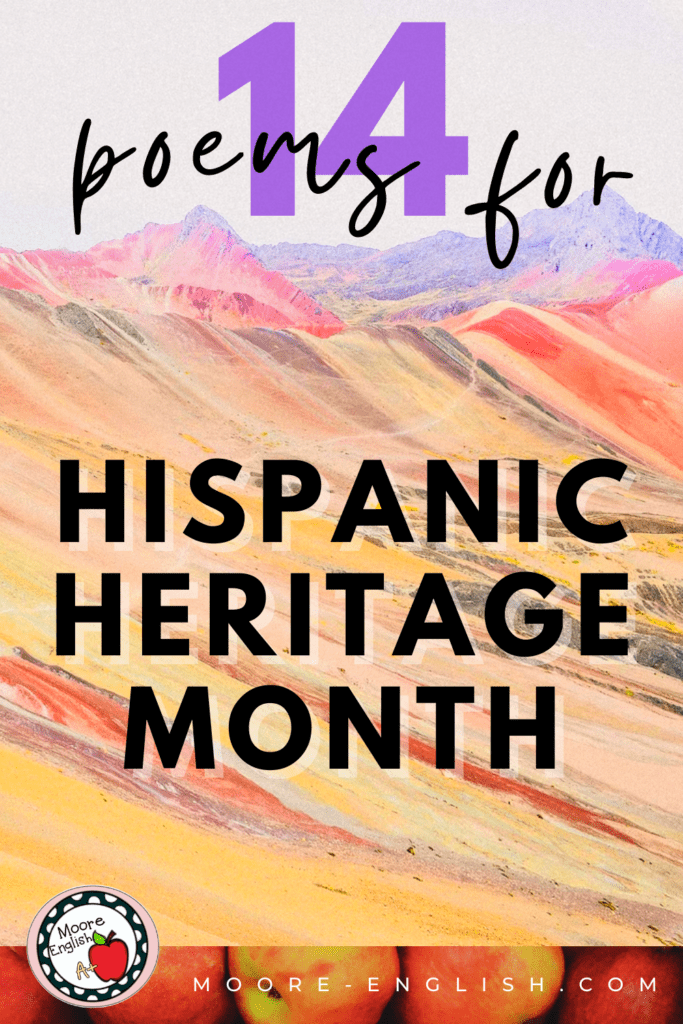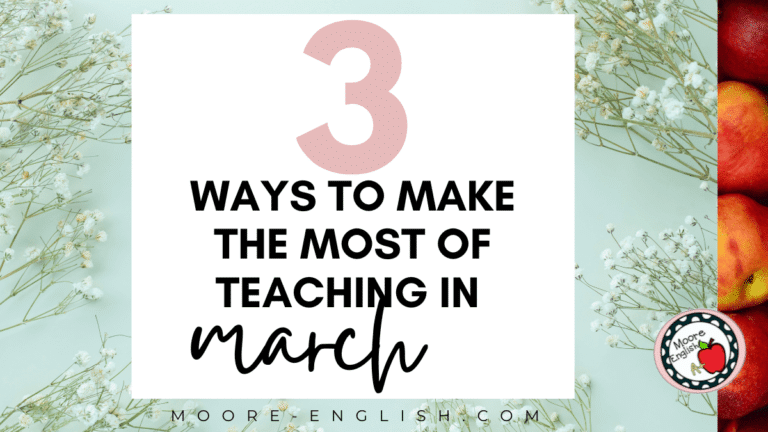One of my goals this year is to incorporate more diverse texts in my classroom. Most of my students are White, and most of the authors and writers we study are also White. However, our community is diverse. The local college is a HBCU. So I know I can do more to invite varied literary voices into the classroom. Since this is Hispanic Heritage Month, I wanted to start here. Check out my poetry suggestions for incorporating more Hispanic and Latino voices in your classroom!
This post this post may contain affiliate links. Please read the Terms of Use.
Positive Poems
One mistake I want to avoid is only choosing texts that feature Black and Brown pain or suffering. For this reason, I started planning for Hispanic Heritage Month with three poems that have positive messages.
- First, “Old Love” by Pat Mora is such a lovely poem. It’s not terribly difficult for students to understand, but it is so touching. Read it here.
- Similarly, I also love “Ode to Teachers” by Pat Mora. Maybe this is a self-serving title, but this is a perfect text for intervention because it is straightforward and uncomplicated. Read it here.
- I also love “Tula [”Books are door-shaped”]” from The Lightning Dreamer by Margarita Engle. I absolutely recommend reading the entire book, but this poem makes a great lesson about the power of literature and finding your voice. Read it here.
Poems of Community
The transportive nature of literature is one of my favorite parts of reading. When an author transports her readers to a different place and time, I am reminded of why I teach reading. These three poems all evoke a sense of community and fit well with Hispanic Heritage Month.
- First, “Home Court” by Jose Olivarez captures the community of a neighborhood, of friendship, and of grief. This is a poem I introduce by focusing on its connection to basketball, but it’s a poem that is about so much more than sports. Read it here.
- Like “Home Court,” the “Latin Deli: An Ars Poetica” by Judith Cofer Ortiz is about far more than a storefront. This is a challenging poem, but it evokes a strong sense of community. I also want to avoid communicating to students that “Hispanic” or “Latino” is monolithic. This poem captures diversity and unity all at the same time. Read it here.
- In “Latin Deli,” Ortiz draws on Spanish language to describe food and family. Similarly, “English” by Marjorie Agosin is all about celebrating language. Maybe it’s the language arts teacher in me, but the sense of community in this poem comes from shared modes of communication. This is kind of a tricky text to find, but I found the poem in the textbook What’s Language Got to Do with It? I also found this .pdf online.
Political Poems for Hispanic Heritage Month
Teaching is a political activity. Avoiding or ignoring that reality simply perpetuates White supremacy, so it is also important to show students that literature can have a political element. Students often struggle to understand the power of language, and these poems each capture and showcase that strength. Consider these political titles for Hispanic Heritage Month.
- First, “The Sign in My Father’s Hands” by Martin Espada captures a son’s perspective of his father. On the one hand, this is a poem about protest, police brutality, and unionizing, but it is also a poem about how we teach our children to stand up for themselves. Read it here.
- Additionally, “lady liberty” by Tato Laviera and “Three Liberties: Past, Present, Yet to Come” by Julia Alvarez focus on the Statue of Liberty and everything she represents. Reading these poems side-by-side allows students to practice synthesis skills. The conversation between these poems also invites a complex conversation about what “liberty” means. Find my resources for both poems in Synthesis Bundle #1.
- Next, “Complaint of El Río Grande” Richard Blanco is told from the perspective of the river. Oftentimes, the Rio Grande is viewed as a dividing line, but Blanco focuses more on the power of water to unify rather than divide. Read it here.
- Of the poems on this list, “Us vs Them” by David Tomas Martinez is the one I have taught the most often. This poem touches on fear, racism, innocence, and the American Dream all at once. It is a challenging poem, but it always engages my students in high-quality conversations. Read it here.
Poems of Structure
CCSS.R.5 is all about structure. It can be tricky to find poems that are engaging but with complex structure. It can be even more challenging to find poems that hit a specific standard and have a specific content. These three poems all have meaningful structures and fit Hispanic Heritage Month.
- First, “December” by Jaquira Diaz is maybe my favorite poem on this list. Written in the shape of a paragraph, this poem comments on so many relatable emotions. There’s a kind of nostalgia in this poem that resonates. Read it here.
- Additionally, “Social Distancing” by Juan Felipe Herrera is a sunburst poem. Of the poems on this list, this one has the most memorable structure. Even looking at the poem captures students’ attention. Furthermore, the subject matter is a common ground for students. Read it here.
- Finally, “Zapotec Crossers (or, Haiku I Write Post-PTSD Nightmares)” by Alan Pelaez Lopez is told in a series of haiku. Students always know about haiku from middle school, but rarely have students seen haiku used to discuss such a powerful subject matter. Read it here.
What poems do you recommend for Hispanic Heritage Month?















